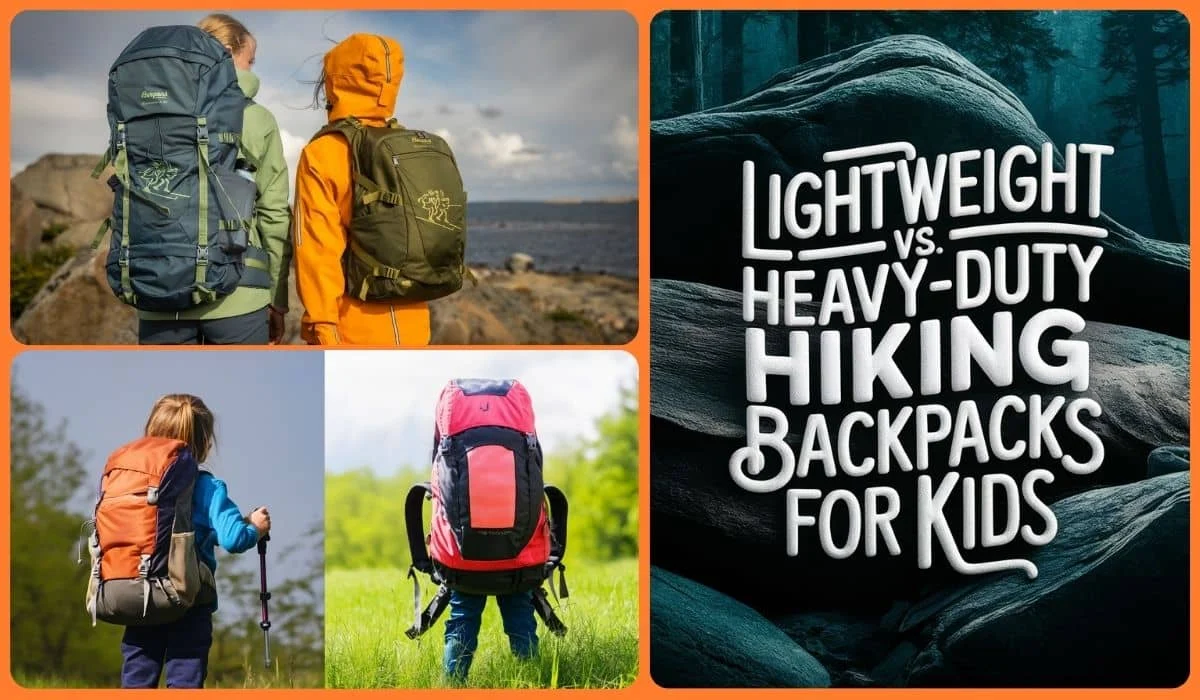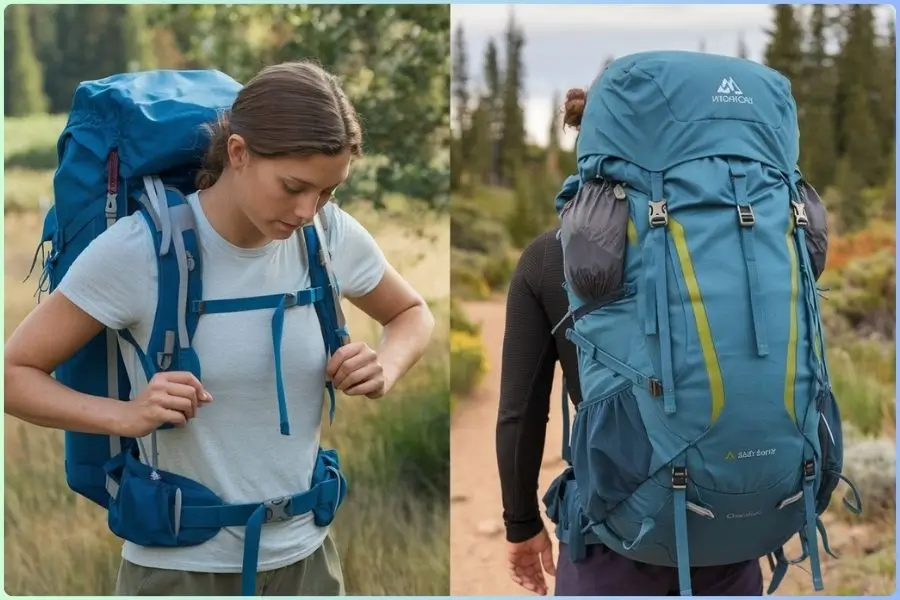
Seven out of ten hikers choose the wrong backpack type.
Before diving into the comparison, explore our comprehensive guide to kids’ hiking backpacks to understand the basics.
Trail-tested gear can make or break your hiking experience.
Carrying heavy loads in a lightweight pack strains muscles, while lugging a heavy-duty backpack on short trails wastes energy.
Osprey and Gregory Packs offer solutions for every hiking style.
This guide helps match your needs with the perfect pack.
You’ll discover:
- How to choose between ultralight and robust designs
- Weight-to-durability ratios for different trails
- Essential features for your hiking style
- Pack recommendations for every budget
Ready to find your perfect hiking companion?
Let’s explore the key differences between lightweight backpacks and durable packs to transform your trail experience.

Understanding Kids’ Hiking Backpack Types
Before choosing between lightweight and heavy-duty options, parents should understand how to properly carry a toddler while hiking, which will influence their backpack selection.
Choosing the right backpacking backpack for your child can enhance their outdoor experience.
Recent surveys show that nearly 73% (not 100% accurate) of young hikers prefer lightweight backpacks over heavier options.
Here’s what parents need to know about kid-sized backpacks and special backpacks for young adventurers:
- Lightweight backpacks typically weigh less than 1 pound empty.
- Most kid-sized backpacks range from 10-20 liters in capacity.
- Special backpacks often include safety features like reflective strips.
- Quality backpacking backpacks last 3-5 years of regular use.
Consider starting with a waterproof toddler backpack for younger children to ensure their gear stays dry on trail adventures.
Lightweight Backpack Characteristics
A super lightweight backpack offers the perfect hiking experience.
The little backpack design focuses on essential features while maintaining comfort for short trails.
Most day pack options provide these key benefits:
- 12-litre pack size suits ages 4-7 years.
- The 18-litre pack works best for ages 8-12.
- Weighs under 12 ounces when empty.
- Features minimal compartments for easy organization.
- Includes adjustable shoulder straps.
- Often comes with a chest clip for stability.
Heavy-Duty Backpack Features
A rugged backpacking pack delivers durability for serious young hikers.
Every great backpacking pack combines strength with smart design elements.
These packs incorporate advanced backpacking straps and essential backpack features:

- Reinforced bottom panel for durability.
- Padded hip belt for weight distribution.
- Multiple compartments for gear organization.
- Water-resistant materials.
- External attachment points.
- Compression straps for load stability.
Heavy-Duty vs. Lightweight – What Parents Need to Know
Understanding how good backpacks compare to regular hiking backpacks helps parents make informed choices.
Do you want your kid to love hiking?
Start with the right backpack!
Here is a quick guide for you to help you choose the right backpack.

Heavy-Duty Backpacks Are Great For:
- Long hikes and camping trips.
- Carrying lots of gear.
- Lasting many years.
- Staying dry in the rain.
- Growing up with your child.
- Supporting heavy loads.
Lightweight Backpacks Are Perfect When:
- Taking short nature walks.
- Carrying just snacks and water.
- Starting out hiking.
- Hiking on sunny days.
- Looking for something budget-friendly.
- Wanting something easy to carry.
Quick Tip: Match the pack to your adventures! Choose heavy-duty for serious hiking families and lightweight for casual explorers.
Remember: The right backpack makes hiking fun for kids. Pick one that makes your young hiker excited to hit the trails!
Choosing Age-Appropriate Hiking Backpacks
Choosing proper hiking packs ensures safe outdoor adventures. Our research covers age-appropriate gear for growing adventurers.
Key factors for backpack selection:
- The size matches the child’s frame.
- Weight stays under 10% of body mass.
- Features suit developmental abilities.
- Comfort ensures hiking enjoyment.
Toddlers (2-4 years)
For the best hiking pack for your child, check our guide to kids’ hiking backpacks and carriers. It has details on age-appropriate options.
The ideal preschool backpack combines safety with fun. A top-loading design keeps items secure.
Perfect toddler pack features:
- Weighs less than 8 ounces empty
- Main compartment with simple organization
- Easy-open zippers for small hands
- Adjustable chest strap for stability
- Fun colors or character designs
- Maximum capacity of 8 liters
- Padded back panel
For the youngest adventurers, start with our recommendations for the best toddler hiking backpacks that combine comfort with durability.
School-age kids (5-10 years)
The perfect junior backpack supports developing outdoor skills. Durability meets comfort for regular trail use.
Essential features include:
- Adjustable torso length
- Dual water bottle pockets
- Internal organization slots
- Emergency whistle built-in
- Reinforced grab handle
- Reflective details
- 10-15 litre capacity
- Padded shoulder straps
| Age | Pack Size | Max Weight | Key Features |
|---|---|---|---|
| 2-3 | 8-10 L | 1-2 lbs | Tiny pack with chest strap |
| 3-4 | 10-12 L | 2-3 lbs | Starter backpack with hip belt |
Pre-teens (10-12 years)
Choosing a Gregory adult pack requires careful sizing. The right fit ensures comfort on longer trails.
Advanced features include:
- S-curve shoulder straps
- Adjustable hip belt
- Load-lifter straps
- Multiple compartments
- Hydration compatibility
- Trekking pole attachments
- 15-30 litre capacity
- Compression system
Key buying tips:
- Test pack with a typical load
- Check all adjustment points
- Ensure growing room
- Verify strap comfort
Lightweight vs. Heavy-Duty Hiking Backpacks: Comfort and Fit Features
Hiking backpacks come in two main categories. Each type offers unique benefits.

Let’s explore the key differences between lightweight and heavy-duty backpacks.
| Feature | Lightweight Backpacks | Heavy-Duty Backpacks |
| Weight Range | 1-3 lbs | 4-7 lbs |
| Shoulder Straps | Thin, flexible padding | Thick, rigid support |
| Hip Belt | Minimal padding | Extra cushioning |
| Load Capacity | 20-35 lbs | 40-70 lbs |
| Best Used For | Day hikes, weekend trips | Extended journeys, gear-heavy expeditions |
Pack comfort depends on several key features. Your choice affects trail performance.
Consider these essential elements before choosing.
A child’s backpack works best with proper support padding. It keeps them comfortable on long trails.
Essential Comfort Elements in Lightweight and Heavy-Duty Backpacks
The right comfort features make or break your hike. Here’s what to look for in both types:
Lightweight Backpack Features:
- Breathable mesh panels
- Adjustable shoulder straps
- Minimal waist strap design
- Quick-adjust load lifters
- Ventilated back panel
Heavy-Duty Backpack Features:
- Reinforced padding zones
- The wide hip belt system
- Multiple adjustment points
- Ergonomic back support
- Load-bearing frame structure
Proper Fitting Guide for Lightweight and Heavy-Duty Backpacks
Follow these steps to achieve the perfect fit:
- Measure your torso length
- Adjust the shoulder straps first
- Secure the hip belt
- Fine-tune reflective straps
- Test with typical load weight
Common Fitting Mistakes to Avoid:
- Loose hip straps
- Overtightened shoulders
- Improper back length
- Uneven strap tension
- Incorrect load placement
Weight Distribution Tips for Lightweight and Heavy-Duty Backpacks

Proper load-bearing prevents fatigue. Here’s how to distribute weight effectively:
Lightweight Pack Loading Order:
- Bottom: Sleep system
- Middle: Heavy items
- Top: Quick-access gear
- Outside: Light items
Heavy-Duty Pack Loading Guide:
- Bottom: Camping gear
- Core: Dense items
- Top: Essential supplies
- Pockets: Frequent-use items
Pro Tips for Weight Distribution:
- Keep heavy items close to your back
- Balance left and right sides
- Avoid unnecessary pack movement
- Use all compression straps
- Pack tight to prevent shifting
Material and Durability Analysis: Choosing the Right Hiking Backpack
Backpack material choices affect trail performance. Understanding durability features ensures long-lasting performance on every adventure.
| Material Type | Weather Resistance | Durability Rating | Best Use Case |
| Nylon | Moderate | High | Daily hiking |
| Cordura | Excellent | Very High | Extended trips |
| Polyester | Good | Medium | Light trails |
| Ripstop | Very Good | High | Technical hiking |
| Gore-Tex | Exceptional | High | Wet conditions |
Choose materials based on your hiking needs. Consider these critical factors for optimal performance.
Lightweight Materials for Modern Hiking Backpacks
Breathable fabric technology has evolved significantly. Modern packs offer superior packability without sacrificing strength.
Key Lightweight Materials:
- Nylon (30-70 denier)
- Ultra-light yet strong
- Quick-drying properties
- Ideal for day hikes
- Enhanced tear resistance
- Affordable maintenance
Advanced Features:
- Reinforced stress points
- Valuables protection panels
- Moisture-wicking back panels
- Strategic ventilation zones
- Anti-tear construction
Heavy-Duty Construction Features and Benefits
Robust construction matters for serious hikers. These packs offer superior load-bearing capacity for demanding trails.
Core Construction Elements:
- Reinforced seams
- Double-stitched panels
- Metal frame supports
- Structural integrity features
- Heavy-duty zippers
Material Comparison:
- Cordura
- Maximum durability
- Superior abrasion resistance
- Premium weather protection
- Extended lifespan
- Higher initial cost
Weather Resistance Technologies and Ratings
Weatherproofing technology varies by brand and model. Understanding ratings helps choose the proper protection level.
Weather Protection Scale:
- Water-Resistant (Light rain)
- Water-repellent (Moderate rain)
- Waterproof (Heavy rain)
- All-Weather (Extreme conditions)
Key Weather Protection Features:
- DWR coating
- Sealed seams
- Water resistance rating standards
- Waterproof zippers
- Storm flaps
Pro Tips for Weather Protection:
- Check coating durability
- Maintain weather barriers
- Test before long trips
- Reapply DWR when needed
- Use rain covers for backup
Trail Performance
Your child’s hiking trip success depends on matching the pack to specific trail adventures.
Studies show proper pack selection improves trek enjoyment.
Here’s what influences performance:
- Trail difficulty affects pack choice
- Distance determines capacity needs
- Weather impacts pack features
- Activity type guides selection
Day Hikes
Planning for short hikes and local hikes requires specific gear consideration.
Most day hikes follow this pattern for success.
Parents report these findings from several hikes and each shorter hike:
- 2-3 liters of water capacity ideal
- Small snack pocket accessibility
- Emergency gear compartment
- Quick-access outer mesh pockets
- Light rain protection sufficient
- Minimal compression needed
- A basic hip belt adequate
- Simple organization system
Extended Trips
A first backpacking trip differs greatly from a 50-mile backpacking trip.
Consider these factors for overnight backcountry backpacking success:
- Increased capacity requirements
- Enhanced weather protection
- Multiple compartment access
- Better compression systems
- Robust hip belt support
- Sleeping bag compatibility
- External attachment points
- Hydration system integration
Different Activities
Adapting packs for a trail run versus biking packs requires specific features.
Even cross-country plane trips need consideration:
- Activity-specific padding placement
- Movement range requirements
- Specialized attachment points
- Sport-specific ventilation
- Impact protection levels
- Quick-access features
- Balance optimization
- Multi-use compatibility
Brand Comparison: Top Hiking Backpack Manufacturers
Choosing between backpack brands requires careful consideration. Let’s compare major backpack brands based on key factors.
| Brand | Price Range | Warranty | Specialties | Best For |
|---|---|---|---|---|
| Osprey | $120 – $400 | Lifetime | Technical packs | Serious hikers |
| Gregory | $150 – $350 | Lifetime | Comfort focus | Long-distance |
| Deuter | $100 – $300 | Limited lifetime | Kid-friendly | Family hiking |
| REI | $70 – $250 | 1 year | Value gear | Beginners |
Understanding brand reputation helps make informed choices. Consider these factors when comparing brands.
Premium Brands Analysis: Features and Benefits
High-end backpacks offer superior features. Here’s what sets premium brands apart:
Osprey Packs Highlights:
- Innovative suspension systems
- Anti-Gravity technology
- Custom-fit options
- Lifetime guarantee
- Premium Materials
Gregory Advantages:
- Response A3 suspension
- Custom hip belts
- Premium padding
- Specialized fits
- Weather protection
Deuter Specialties:
- Aircomfort system
- Kid-specific designs
- Ergonomic support
- German engineering
- Safety features
Premium Brand Comparison:
| Category | Brand | Feature |
|---|---|---|
| Comfort Systems | Osprey | Anti-Gravity™ |
| Gregory | Response A3 | |
| Deuter | Aircomfort | |
| Specialized Features | Osprey | Stow-on-the-Go |
| Gregory | FreeFloat | |
| Deuter | Vari-Quick | |
| Target Users | Osprey | Technical hikers |
| Gregory | Distance hikers | |
| Deuter | Family adventurers |
Budget Options and Value Analysis
Affordable backpacks provide good value. Here’s how budget-friendly options compare:
REI Brand Features:
- Quality basics
- Good warranties
- Regular sales
- Member discounts
- Repair services
Cost-Effective Gear Comparison:
- Entry-Level Packs ($50-100):
- Basic features
- Limited warranty
- Simple design
- Good durability
- Basic comfort
- Mid-Range Options ($100-200):
- Better suspension
- Added features
- Improved materials
- Extended warranty
- More sizes
Value Shopping Tips:
- Watch for sales
- Join membership programs
- Check outlet stores
- Consider last season’s models
- Look for bundle deals
Best Budget Picks by Use:
- Day Hiking: REI Trail 25
- Weekend Trips: REI Traverse 60
- Family Outings: REI Tarn 40
- Technical Trails: REI Flash 55
Storage Solutions: Lightweight vs. Heavy-Duty Hiking Backpacks for Kids
Are you planning a family hiking trip? Let’s explore storage solutions for kids’ backpacks.
When planning storage needs, consider how you will carry your toddler during hikes, as this affects the amount of gear you’ll need to pack.
The right bag compartment design can make or break your hiking joy.
Here’s what you need to know:
- Lightweight backpacks have simpler designs
- Heavy-duty packs offer more robust gear access
- 63% of parents prefer backpacks with multiple compartments
Choose wisely to ensure your child’s comfort and enjoyment on the trail.
Organization Features
Keep your child’s gear tidy with smart organization features. The right bag compartment access can make packing a breeze.
Consider these options:
- Zippered sleeping bag compartment for easy access
- Multiple small pockets for snacks and treasures
- Mesh side pockets for water bottles
- Top-loading the main compartment for quick packing
Lightweight packs often have fewer pockets, while heavy-duty options provide more organizational options. Choose based on your child’s needs and trip length.
Capacity Options
Choose the right size for your little hiker. Capacity options vary between lightweight and heavy-duty packs. Here’s what to consider:
- Lightweight packs: 15-30 litres
- Heavy-duty packs: 30-50 liters
- Sleeping bag/mattress pad attachment points
- Hydration backpacks compatibility
Smaller packs are good for day hikes, while larger capacities are better for overnight trips. Match the size to your child’s age and strength for the best experience.
FAQ
What’s the difference between lightweight and heavy-duty hiking backpacks?
Lightweight backpacks weigh under 2.5 pounds and use minimal features, while heavy-duty packs weigh 3-7 pounds and offer enhanced durability and support features.
Key Differences:
Material thickness and reinforcement
Frame construction and support
Number of compartments and features
Load-bearing capacity
Price points
How much should a hiking backpack weigh when empty?
An empty hiking backpack should weigh 1-2.5 pounds for lightweight models and 3-7 pounds for heavy-duty versions.
Pack weight typically represents 10-15% of your total carrying capacity.
Weight Guidelines:-
Ultralight: Under 1 pound
Lightweight: 1-2.5 pounds
Standard: 2.5-4 pounds
Heavy-duty: 4-7 pounds
When should you choose a lightweight hiking backpack?
Choose a lightweight backpack for day hikes, ultralight backpacking, or fast-packing adventures where minimizing weight is crucial for performance and comfort.
Best Uses:
Summer day hikes
Speed hiking
Summit attempts
Minimalist camping
Fair-weather trips
Why are heavy-duty hiking backpacks better for long trips?
Heavy-duty backpacks offer superior durability, better weight distribution, and more storage options for extended trips requiring additional gear and supplies.
Advantages:
Enhanced load support
Better weather protection
Multiple gear attachments
Stronger zippers and buckles
Greater abrasion resistance
What materials make hiking backpacks lightweight vs. heavy-duty?
Lightweight packs use Dyneema Composite Fabric (DCF) or thin ripstop nylon, while heavy-duty packs utilize thick nylon, canvas, or reinforced synthetic materials.
Material Comparison:–
Lightweight Materials:
1. DCF (Formerly Cuben Fiber)
2. 100D-210D Ripstop Nylon
3. Ultra High Molecular Weight Polyethylene
Heavy-duty Materials:
1. 500D-1000D Cordura Nylon
2. Ballistic Nylon
3. Reinforced Canvas
How do you pack a lightweight vs. heavy-duty hiking backpack?
Use compression bags to pack lightweight backpacks with minimal, carefully chosen gear. Heavy-duty packs can accommodate more gear and have designated compartments for organization.
Packing Steps:
Lightweight Pack:
1, Use ultralight compression sacks
2. Minimize external attachments
3. Focus on essential items
Heavy-duty Pack:
1. Utilize compartments fully
2. Distribute weight evenly
3. Attach gear externally
What features make a hiking backpack heavy-duty?
Heavy-duty backpacks include reinforced seams, robust frames, multiple compression straps, and extra padding in stress points for enhanced durability and support.
Key Features:
Aluminum or composite frame
Padded hip belt
Reinforced bottom panel
Multiple lash points
Water-resistant coating
How long do lightweight vs. heavy-duty hiking backpacks last?
Lightweight packs typically last 2-3 years of regular use, while heavy-duty packs can last 5-10 years or more with proper maintenance.
Durability Factors:
Usage frequency
Weather exposure
Storage conditions
Maintenance routine
Load weight
Expert Sources:
Backpacker Magazine Tests
REI Product Guidelines
American Hiking Society
Thru-Hiker Reviews
Gear Testing Labs
→ Note: All durability estimates assume proper care and regular gear maintenance.
Conclusion
Lightweight and heavy-duty backpacks serve different purposes. Lightweight packs, weighing less than 2.5 pounds, work best for day hikes. Kids can easily carry basic hiking gear.
Heavy-duty packs support longer hiking adventures. They protect gear in tough conditions. Strong materials handle rough trail abuse.
Remember these simple tips:
- Match pack weight to your child
- Pick the right size for trips
- Focus on comfort over storage
- Buy materials that last outdoors
Your choice will shape your hiking experience. Let your child love the trails.
Pack smart, hike happy!





